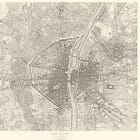Magic School
In this week’s post we took a brief look at Eustache Deschamps (1346-1406/7). A prolific poet and translator, well-connected bloke and member (leader?) of the Society of Smokers (subgiez de fumeux), he used the pen-name ‘Morel’ (Nightshade).
I briefly touched on his life in the mid-fourteenth century, around the time the Black Death was picking up, at the University of Orléans. This was to reference student life and the potential Bullingdon-esque origins of the Smokers, but it segues nicely now. The Medieval Orléans University was like to Cambridge as Paris was to Oxford—scholars left and set up elsewhere in the mid/early thirteenth century.
Orléans became known as a centre for law, attracting at least one Saint (Yves) and two Popes including Clement V who formalised its university privileges by Papal bull in 1306. In the fourteenth century, it was huge, educating up to 5000 students from across France and Europe—including many Scots and Germans. The famous early modern jurist, Pothier (1699-1702), was also an alumnus. Deschamps was there to read law himself, between piss-ups.
Yet, in Chaucer’s Franklin’s Tale (c.1399) we are told Orléans has another reputation—students go there to ‘study law’ and come back magicians (or tregetours, meaning ‘conjurer’ or ‘illusionist’):
‘…At Orliens in studie a book he say//Of magyk natureel, which his felawe//That was that tyme a bacheler of lawe//Al were he ther to lerne another craft…’
Anyway. Orléans University declined over the centuries and would eventually be closed in 1793. In the 19th century it merged with the University of France thanks to sweeping reforms. Since 1960, we have the current, new (refounded?), University of Orléans, 2 years after the University of New Orleans.
I do love university history.
I do not own the images shared in this post.









